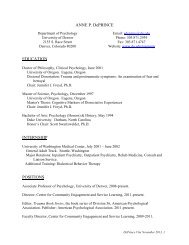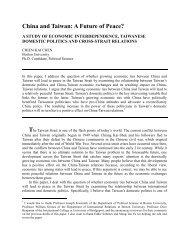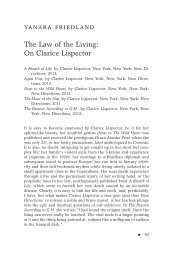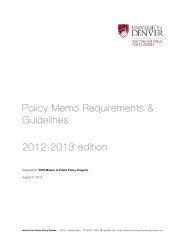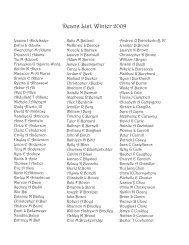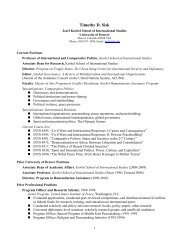Through a Speculum That Shines: Vision and Imagination in ...
Through a Speculum That Shines: Vision and Imagination in ...
Through a Speculum That Shines: Vision and Imagination in ...
Create successful ePaper yourself
Turn your PDF publications into a flip-book with our unique Google optimized e-Paper software.
History of Religions Feb 1997 v36 n3 p265(10) Page 6<br />
<strong>Through</strong> a <strong>Speculum</strong> <strong>That</strong> <strong>Sh<strong>in</strong>es</strong>: <strong>Vision</strong> <strong>and</strong> <strong>Imag<strong>in</strong>ation</strong> <strong>in</strong> Medieval<br />
Jewish Mysticism.<br />
(8) On p. 306 Wolfson makes the move from sheth<strong>in</strong>ah as<br />
locus of vision to sheth<strong>in</strong>ah as <strong>in</strong>strument of vision to<br />
shek<strong>in</strong>ah as optic hole through which the vision is seen.<br />
(9) On p. 316 he discusses an `Iyyun passage devoid of<br />
sexual imagery that attributes imag<strong>in</strong>ation to the n<strong>in</strong>th<br />
sefirah. Wolfson promptly rem<strong>in</strong>ds the reader that this is<br />
"the div<strong>in</strong>e phallus" <strong>and</strong> has us on our way to "the phallic<br />
imag<strong>in</strong>ation." For other examples of gratuitous<br />
underscor<strong>in</strong>g of the phallic association with the n<strong>in</strong>th<br />
sefirah, see pp. 245, 359, <strong>and</strong> 363, n. 126, etc. There are<br />
a few places <strong>in</strong> this very long <strong>and</strong> text-filled book where<br />
Wolfson’s read<strong>in</strong>gs are supported by questionable<br />
translations. (These may be the result of wishful th<strong>in</strong>k<strong>in</strong>g,<br />
s<strong>in</strong>ce Wolfson’s Hebrew is generally superb.) Thus the<br />
passage by Jacob bar Sheshet on p. 360 does not say,<br />
"Permission has not been granted to write [about this],"<br />
lead<strong>in</strong>g one to jo<strong>in</strong> <strong>in</strong> the presumption of self-censorship of<br />
a dangerously erotic reference. The passage rather refers<br />
to the Oral Torah, which "was not given to be written." On<br />
p. 362 he quotes Todros Abulafia, comment<strong>in</strong>g on the<br />
crowns of light to be given to the righteous <strong>in</strong> the future.<br />
On that day, Wolfson translates, "one does not have need<br />
for eat<strong>in</strong>g <strong>and</strong> dr<strong>in</strong>k<strong>in</strong>g, for this [i.e., receiv<strong>in</strong>g the light] is<br />
actual eat<strong>in</strong>g." But `akhilah wadat’it has a different sense,<br />
that of the "true" eat<strong>in</strong>g, someth<strong>in</strong>g higher or better than<br />
"actual eat<strong>in</strong>g." Thus Wolfson’s conclusion from the<br />
passage, "eat<strong>in</strong>g . . . obviously to be understood as a<br />
symbol for <strong>in</strong>tegrative union:’ is highly questionable, s<strong>in</strong>ce<br />
all of this is tied back to his claim that "the kabbalists are<br />
crowned <strong>in</strong> the light of the corona of the penis" (p. 360). It<br />
thus seems important to say that here there is no eat<strong>in</strong>g;<br />
the Kabbalist neither consumes nor is consumed by the<br />
div<strong>in</strong>e phallus, but merely basks <strong>in</strong> the div<strong>in</strong>e light. There is<br />
<strong>in</strong> fact no "eat<strong>in</strong>g" here, but direct sustenance of the<br />
righteous by div<strong>in</strong>e light. Even <strong>in</strong> a passage deal<strong>in</strong>g with<br />
the key symbol of the book (p. 274), I am not sure that<br />
Wolfson is correct <strong>in</strong> capitaliz<strong>in</strong>g the "H" of "His" <strong>in</strong> the<br />
sentence: "Thetenth sefirah is the speculum that does not<br />
sh<strong>in</strong>e, <strong>and</strong> it is like a glass mirror, <strong>and</strong> the one who looks<br />
at it sees His [my emphasis] image with<strong>in</strong> it." But that letter<br />
makes all the difference: What is it that the prophet is<br />
see<strong>in</strong>g through that unlit glass-God or his own self?<br />
(10) For a sampl<strong>in</strong>g of these <strong>in</strong> English translation, as well<br />
as a good general <strong>in</strong>troduction to the place of shekh<strong>in</strong>ah <strong>in</strong><br />
the Zohar, the reader may want to consult Isaiah Tishby’s<br />
Wisdom of the Zohar (Oxford: Littman Library, 1991), vol.<br />
1. (11) A key statement of Wolfson’s view is to be found on<br />
pp. 274-75, n. 14. While he claims to be quite aware (as of<br />
course he is) of the rich literature of shekh<strong>in</strong>ah depictions<br />
<strong>in</strong> the Zohar, these are all dismissible because they<br />
represent her only <strong>in</strong> her exilic state. "Even the image of<br />
the Shekh<strong>in</strong>ah as a bride adorned for her wedd<strong>in</strong>g is a<br />
transition between exile <strong>and</strong> redemption. The latter is fully<br />
represented when the bride enters the nuptial chamber<br />
<strong>and</strong> is transformed there<strong>in</strong> . . . for the bride has become<br />
the corona of the penis."<br />
(12) The key study here is Scholem’s "Shekh<strong>in</strong>ah: The<br />
Fem<strong>in</strong><strong>in</strong>e Element <strong>in</strong> Div<strong>in</strong>ity," <strong>in</strong> his On the Mystical<br />
Shape of the Godhead.<br />
(13) See, e.g., the Zohar passages quoted on p. 372, n.<br />
155.<br />
(14) In Kabbalistic terms one might say that I f<strong>in</strong>d a<br />
disturb<strong>in</strong>g perud (separation) <strong>in</strong> Wolfson’s read<strong>in</strong>g<br />
between the sixth <strong>and</strong> n<strong>in</strong>th sefirot, which <strong>in</strong> the<br />
Kabbalistic context is tantamount, among other th<strong>in</strong>gs, to a<br />
separation of sex from love.<br />
(15) I am th<strong>in</strong>k<strong>in</strong>g of the highly romantic <strong>and</strong> less genital<br />
expressions of the love relationship between tif’eret <strong>and</strong><br />
shekh<strong>in</strong>ah found <strong>in</strong> the works of Kabbalists from Joseph<br />
Gikatilla, a member of the Zohar circle, to Meir Ibn Gabbai<br />
<strong>in</strong> sixteenth-century Turkey.<br />
(16) He tries to buttress this read<strong>in</strong>g with an even more<br />
problematical read<strong>in</strong>g of a midrash, which says that the<br />
women of Egypt were startled when they beheld the "yofyo<br />
shel Yosef" (the beauty of Joseph), mean<strong>in</strong>g that they<br />
gazed at his phallus. But what prompts him to make these<br />
Egyptian ladies <strong>in</strong>to Playgirl readers? Is male beauty only<br />
phallic? Even today viewers of soap operas swoon at the<br />
faces of lovely young men, <strong>and</strong> that seems to be quite<br />
enough for them.<br />
(17) I am not deny<strong>in</strong>g categorically the possibility of such<br />
<strong>in</strong>terpretations, which are found <strong>in</strong> Liebes’s writ<strong>in</strong>gs ("The<br />
Messiah of the Zohar" [n. 6 above], <strong>and</strong> "Zohar <strong>and</strong> Eros"<br />
[n. 6 above]) as well as Wolfson’s. I mean rather that one<br />
cannot take them for granted. There is a need to<br />
dist<strong>in</strong>guish clearly between discussion of the n<strong>in</strong>th sefirah,<br />
where the Kabbalists themselves use phallic language,<br />
<strong>and</strong> the uppermost sefirot, where such terms are not used.<br />
In the latter case, it is only the scholarly <strong>in</strong>terpreter who<br />
reads the symbols this way, <strong>and</strong> such <strong>in</strong>terpretations are<br />
always open to question.<br />
(18) I f<strong>in</strong>d this term somewhat mislead<strong>in</strong>g; "imag<strong>in</strong>ative"<br />
might do better.<br />
(19) This is the Kabbalistic theology adumbrated, e.g., <strong>in</strong><br />
the famous patah eliyahu, a passage from the <strong>in</strong>troduction<br />
to Tiqquney Zohar, pr<strong>in</strong>ted <strong>in</strong> the Sephardic prayerbook<br />
<strong>and</strong> recited daily as a sort of Kabbalistic credo. <strong>Through</strong>out<br />
their history Kabbalists have discussed the question of<br />
- Repr<strong>in</strong>ted with permission. Additional copy<strong>in</strong>g is prohibited. - G A L E G R O U P<br />
Information Integrity



